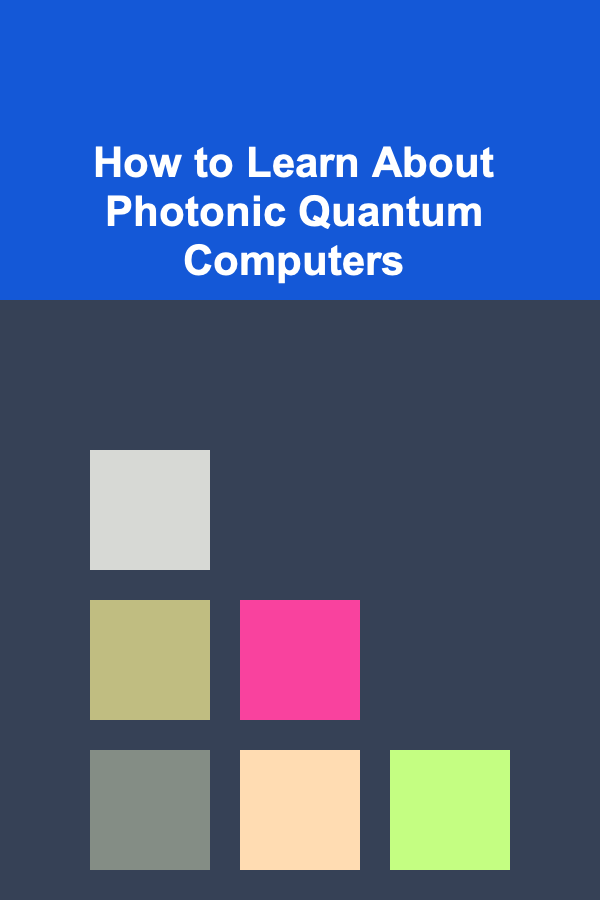
How to Learn About Photonic Quantum Computers
ebook include PDF & Audio bundle (Micro Guide)
$12.99$7.99
Limited Time Offer! Order within the next:

Photonic quantum computers represent one of the most exciting frontiers in modern computing. Leveraging the properties of photons --- particles of light --- to carry and process information, these quantum systems promise to revolutionize computing, potentially outperforming classical computers in solving complex problems related to cryptography, drug discovery, artificial intelligence, and more.
However, understanding photonic quantum computing requires a multidisciplinary approach, encompassing physics, quantum mechanics, engineering, and computer science. This article aims to provide a comprehensive guide on how to learn about photonic quantum computers, covering foundational concepts, key technologies, current research, and the future prospects of this emerging field.
Understanding Quantum Mechanics: The Basis of Quantum Computing
Before diving into the specifics of photonic quantum computers, it's essential to grasp the basics of quantum mechanics. Quantum computing, regardless of the implementation method, relies on the principles of quantum physics to process information in ways that classical computers cannot.
The Fundamental Concepts of Quantum Mechanics
At the core of quantum mechanics are several principles that deviate from classical physics:
- Superposition: In classical computing, a bit can be either a 0 or a 1. In quantum computing, a quantum bit (qubit) can exist in a superposition of both 0 and 1 simultaneously. This allows quantum computers to explore multiple solutions to a problem at once, offering a potential speedup in solving certain types of problems.
- Entanglement: When two qubits become entangled, the state of one qubit is instantaneously related to the state of the other, regardless of the distance between them. This property enables quantum computers to perform parallel computations more efficiently than classical computers.
- Quantum Interference: Quantum algorithms leverage interference to amplify the probability of correct solutions and cancel out incorrect ones. This property is crucial for achieving the exponential speedup offered by quantum computing.
- Measurement: In quantum mechanics, measuring a quantum state collapses it to one of its possible outcomes. This means that the outcome of a quantum computation can only be known after measurement, which makes quantum algorithms more probabilistic than deterministic.
Resources for Learning Quantum Mechanics
To build a strong foundation in quantum mechanics, you can begin with introductory textbooks, online courses, and lecture series. Some recommended resources include:
- Books: "Introduction to Quantum Mechanics" by David J. Griffiths and "Quantum Computation and Quantum Information" by Michael A. Nielsen and Isaac L. Chuang.
- Online Courses: Platforms like Coursera, edX, and MIT OpenCourseWare offer courses in quantum mechanics and quantum computing.
- Lecture Series: YouTube channels such as "PBS Space Time" and "MinutePhysics" provide visually engaging explanations of quantum mechanics concepts.
Exploring Quantum Computing: The Basics
Once you understand the fundamentals of quantum mechanics, the next step is to explore the core concepts of quantum computing.
What Is Quantum Computing?
Quantum computing harnesses quantum mechanics to process information in fundamentally different ways than classical computers. While classical computers use binary bits to represent information as 0s or 1s, quantum computers use quantum bits (qubits), which can represent both 0 and 1 simultaneously due to superposition.
Quantum computers use quantum gates, which manipulate qubits' states through operations like rotation and entanglement. Unlike classical logic gates, which perform logical operations on bits, quantum gates perform operations that take advantage of quantum superposition and entanglement, enabling more powerful computations.
Types of Quantum Computers
There are several different approaches to building a quantum computer. The two most prominent ones are:
- Superconducting Qubits: Superconducting quantum computers use circuits made of superconducting materials to create qubits. Companies like IBM and Google are actively working on this technology.
- Trapped Ions: This approach uses individual ions trapped in electromagnetic fields, manipulated with lasers to perform quantum operations. IonQ is a leading company in this field.
- Photonic Quantum Computers: Instead of using particles like ions or superconducting materials, photonic quantum computers use photons as qubits. This approach has a number of unique advantages, including lower error rates and the potential for room-temperature operation, making it a promising candidate for large-scale quantum computing.
Recommended Resources for Learning Quantum Computing
- Books: "Quantum Computation and Quantum Information" by Michael A. Nielsen and Isaac L. Chuang is considered the definitive textbook for quantum computing.
- Online Courses: "Quantum Computing for the Determined" by Michael Nielsen (available on YouTube) and "Quantum Computing Fundamentals" on Coursera.
- Quantum Development Kits: Explore quantum programming languages and simulators such as IBM's Qiskit or Microsoft's Q# to gain hands-on experience with quantum algorithms.
Introduction to Photonic Quantum Computing
Photonic quantum computing is a subfield of quantum computing where photons are used to represent qubits. Unlike other quantum computing approaches, photonic quantum computers use light particles to carry and process quantum information. Photons are naturally well-suited for quantum computing because they are not easily disturbed by environmental factors, leading to lower error rates.
Why Photons?
Photons are chosen for several key reasons:
- Long Coherence Times: Photons have relatively long coherence times compared to other quantum systems, meaning they can maintain their quantum states over longer periods.
- Room-Temperature Operation: Unlike superconducting qubits or trapped ions, photonic quantum computers can operate at room temperature, making them more practical for large-scale deployment.
- Ease of Manipulation: Photons can be easily manipulated using optical components such as beam splitters, phase shifters, and wave plates, which makes building photonic quantum circuits relatively straightforward compared to other approaches.
Key Technologies in Photonic Quantum Computing
To understand photonic quantum computers, it's crucial to know about the key technologies that enable them:
- Photon Sources: Photonic quantum computers require a source of entangled photons. These can be produced using techniques like spontaneous parametric down-conversion, where a high-energy photon is split into two lower-energy entangled photons.
- Linear Optics: Quantum gates in photonic systems are typically implemented using linear optical components, such as beam splitters, mirrors, and phase shifters. These components manipulate the quantum states of photons without altering their fundamental properties.
- Detection: Quantum photodetectors are used to measure the quantum state of photons. These detectors must be extremely sensitive and capable of detecting single photons.
- Quantum Interference: Quantum algorithms for photonic quantum computers exploit interference effects to perform computations. Interference is used to combine different photon paths, reinforcing correct solutions while canceling out incorrect ones.
Leading Photonic Quantum Computing Companies
Several companies and research institutions are working on photonic quantum computing:
- PsiQuantum: PsiQuantum aims to build a scalable photonic quantum computer, with a focus on using silicon photonics for large-scale integration.
- Xanadu: Xanadu is working on photonic quantum computing using integrated photonic chips. Their product, "Borealis," has been one of the first photonic quantum computers to demonstrate quantum advantage.
- Lightelligence: Focuses on integrating photonics with quantum computing to improve computational efficiency and scalability.
Research and Papers in Photonic Quantum Computing
To keep up with the latest advancements in photonic quantum computing, it's essential to follow the latest research papers and academic publications. Some journals and conferences that regularly feature cutting-edge research on photonic quantum computing include:
- Nature Photonics
- Physical Review X
- Quantum Science and Technology Journal
- International Conference on Quantum Technologies (ICQT)
The Challenges of Photonic Quantum Computing
While photonic quantum computing holds tremendous promise, it faces several challenges that researchers are working to overcome:
- Scalability: Building large-scale photonic quantum computers requires creating a high number of entangled photons, which is difficult to achieve reliably.
- Photon Loss: Photons are prone to losses as they travel through optical fibers or components, which can degrade the performance of photonic quantum computers.
- Error Correction: Quantum error correction is a critical issue in all forms of quantum computing, and photonic quantum computers are no exception. Developing effective error correction codes for photonic qubits is an ongoing challenge.
Future of Photonic Quantum Computing
The future of photonic quantum computing is incredibly promising. As technology advances, the advantages of photons --- such as their speed and low error rates --- will become even more pronounced. Moreover, as photonic quantum computers become more scalable, we could see the realization of practical quantum machines that can solve problems deemed intractable by classical computers.
Photonic quantum computing could revolutionize various industries, including:
- Cryptography: Photonic quantum computers could break classical encryption schemes, prompting the development of quantum-resistant cryptography.
- Artificial Intelligence: Quantum machine learning could vastly speed up training algorithms, enabling breakthroughs in AI research.
- Drug Discovery: Quantum simulations could lead to faster and more accurate predictions in drug design, improving healthcare.
Conclusion
Learning about photonic quantum computers requires an understanding of quantum mechanics, quantum computing, and the specific technologies used in photonic systems. While the field is still in its infancy, the potential for photonic quantum computers to revolutionize various industries makes it an exciting area of study. By exploring the resources outlined above, diving into the key technologies, and staying updated with the latest research, you can build a deep understanding of photonic quantum computing and its future impact on society.

How to Organize Family Photos and Keepsakes
Read More
How to Prepare for Financial Setbacks Before They Happen
Read More
How to Use Carabiners and Clips for Quick Access Gear
Read More
How to Puree Soups and Sauces
Read More
How to Design a Home Office for Productivity
Read More
Learning to Love Yourself: The Key to Loving Others
Read MoreOther Products

How to Organize Family Photos and Keepsakes
Read More
How to Prepare for Financial Setbacks Before They Happen
Read More
How to Use Carabiners and Clips for Quick Access Gear
Read More
How to Puree Soups and Sauces
Read More
How to Design a Home Office for Productivity
Read More